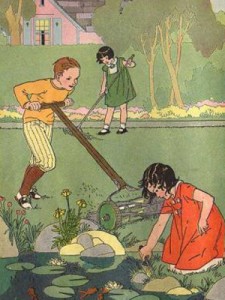By Callista Haggis (@CallistaAnne) and Karim Khan
 They are the bane of what should be a fun weekend of socialising, watching sport on TV (I mean exercising) and checking out BJSM on your iPad. Household bloody chores. The newspapers loved two of BJSM’s recent papers and inspired the bold and over- simplistic headline above. But given the time that both women and men spend on household chores, consider what Ratzlaff, Brown and Blair tell us about the scientific evidence on domestic and occupational activities.
They are the bane of what should be a fun weekend of socialising, watching sport on TV (I mean exercising) and checking out BJSM on your iPad. Household bloody chores. The newspapers loved two of BJSM’s recent papers and inspired the bold and over- simplistic headline above. But given the time that both women and men spend on household chores, consider what Ratzlaff, Brown and Blair tell us about the scientific evidence on domestic and occupational activities.
Harvard’s Charles Ratzlaff’s ‘take home message’ is in his title: Good news, bad news: sports matter but occupational and household activity really matter – sport and recreation unlikely to be a panacea for public health. In his rigorous population database analysis, ”sporting activity formed a small fraction of overall physical activity compared with occupational and household activity.”
What subset of the population spent 10 times more energy in household activity, and 5.5 times in occupational activity? You guessed it, women.
Ratzlaff’s research contributions are important when viewed in context with epidemiology’s historic gender bias in reporting on non-sport specific activities (data were often focused on the male-dominated activities).
However, the ‘bad news’, echoed by Professors Brown and Blair, is that “overall population levels of exercise fall below the recommendations of public health bodies and expert clinical groups.”
Ratzlaff points out that individuals (of both sexes!) may benefit from additional energy expenditure without participating in ‘formal sporting activities.’ However, Brown and Blair state, “for most people, occupational activity is not at a level to improve fitness.” Fitness is associated with better health outcomes than being a healthy weight and unfit [Blair BJSM 2009, pages 1-2). Additionally, Brown and Blair’s data suggest that domestic activities do not produce the same feelings of ‘well being’ as leisure/transport activity for young women.
Taken together, the key message to pass on to patients, clients, and the general population may be: Nothing is a panacea for public health. If you can incorporate physical activity (in different settings) into daily routines – good, if you can improve fitness and enjoy physical activity – even better.
And just because BJSM is keen for everyone to be aware of this very important ‘overview’ of how physical activity can be incorporated in the different sectors where evidence is strong – please check out the ‘7 Investments’ for Physical Activity document (free) – and share it around! [GAPA document from August; Ed Choice]
References
Related blog
***************************************************************
Callista Haggis, MAP, is the Knowledge Broker for Active Streets, Active People (ASAP) – a Centre for Hip Health and Mobility research project on the relationship between the built environment and social and physical activity across the lifespan. Follow her on twitter: @CallistaAnne. Follow ASAP on twitter @AsapActive